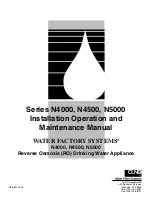
7
4. Air Supply
Warning
1. Use clean air.
Do not use compressed air that includes chemicals, synthetic oils containing organic solvents,
salinities or corrosive gases, etc., as it can cause damage or malfunction.
2. Pay attention to avoid freezing when operating the product in low temperatures.
The equipment operates while expanding the compressed air. During this time, the temperature
inside the product decreases due to adiabatic expansion. If the ambient temperature is low, using
compressed air containing a lot of moisture may cause freezing because heat cannot be gained
from the surroundings. In this case, take freeze prevention measures by using a membrane air
dryer (such as series IDG).
Caution
1. Quality of operating air
- Be sure to use only air filtrated by a micro mist separator (such as series AMD). Use of a super
mist separator (such as series AME) is recommended to extend maintenance intervals.
-
When dew forming or freezing occur in the process pump, use the membrane air dryer (IDG)
and decrease the dew point of supply air.
- If a pump is operated by N2 gas, etc., the deterioration of the gaskets inside the switching valve
will be accelerated and may result in substantially shortening the life span of the product.
2. Compressed air with low dew point
If compressed air with an atmospheric dew point below -40
o
C is used, the lubrication properties
inside the equipment can deteriorate prematurely, affecting the life of the equipment.
When compressed air with an atmospheric dew point below -40
o
C is used for the operating
environment or as supply air, testing under user
’s operating conditions is recommended.
5. Operating environment
Warning
1. Do not use in the following environments, as this can cause failure.
1) Locations with an atmosphere of corrosive gases, organic solvents or chemical solutions, and
where there may be contact with the same.
2) Locations where there is contact with sea spray, water or steam.
3) Locations where ultraviolet deterioration or overheating of resin may occur due to direct
sunlight.
4) Locations near heat sources with poor ventilation (heat sources should be shielded by heat
insulating material).
5) Locations with impact or vibration.
6) Locations with excessive moisture and dust.
2. The product cannot be used under water.
Do not use the product immersing it in water (liquid). Otherwise, liquid will enter the openings
inside the product, resulting in malfunction.
3. Depending on the fluid used, a flammable atmosphere may occur. Take measures
such as ventilation.
6. Maintenance
Warning
1. Perform maintenance after consulting the operation manual.
Obtain the operation manual for the equipment from SMC or our distributor and have sufficient
knowledge of the equipment before performing maintenance. Incorrect handling may cause
damage or malfunction of the equipment or system.
2. Perform maintenance work after confirming the safety of the system.
Turn off the compressed air and power supply and exhaust any remaining compressed air in the
system before removing the equipment and the compressed air supply/exhaust unit. Discharge
the residual liquid or sufficiently displace it as necessary. Also, when reinstalling the equipment or
restarting it after replacement, confirm the safety of the product before checking that it operates
normally.





































